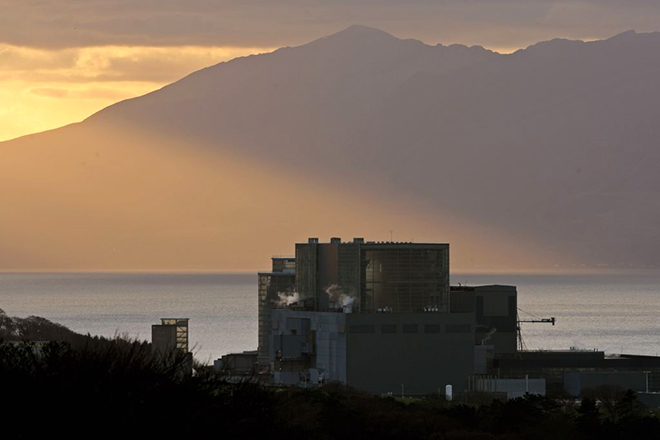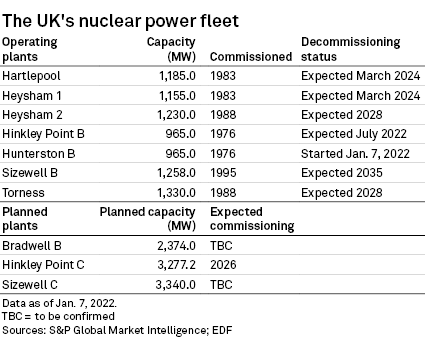S&P Global Offerings
Featured Topics
Featured Products
Events
S&P Global Offerings
Featured Topics
Featured Products
Events
S&P Global Offerings
Featured Topics
Featured Products
Events
Banking & Capital Markets
Economy & Finance
Energy Transition & Sustainability
Technology & Innovation
Podcasts & Newsletters
Banking & Capital Markets
Economy & Finance
Energy Transition & Sustainability
Technology & Innovation
Podcasts & Newsletters
S&P Global Offerings
Featured Topics
Featured Products
Events
7 Jan, 2022
By Alex Blackburne

|
EDF's Hunterston B nuclear plant was shut down Jan. 7 after nearly 46 years of operation. |
EDF Energy Ltd. shut down its Hunterston B nuclear power station in Scotland on Jan. 7, with three more major plant retirements expected by 2024 that will see more than half of Britain's nuclear capacity go offline.
The closure of the plant, which began operating in 1976, reduces the U.K.'s 7.9-GW nuclear power fleet by almost 1 GW, according to the U.K. Nuclear Industry Association. The remaining six plants, all operated by EDF, account for around 16% of Britain's electricity demand, the group said.
Hunterston B is the latest in a series of nuclear shutdowns in the U.K. by the Electricité de France SA subsidiary, which began decommissioning its 1,214-MW Dungeness B plant in June 2021. Meanwhile, Hinkley Point B is slated to close in July, followed by Hartlepool and Heysham 1 in March 2024.
 |
By that point, Britain will be left with just 3.65 GW of nuclear generation. In fact, all but one of the current fleet will retire by 2028.
The U.K. is joined by the likes of Germany and Belgium in closing nuclear plants, but in contrast to those countries, which are on a path to completely phasing out the technology, plans are in motion for a new era of nuclear power development in the U.K.
The Nuclear Industry Association estimates the market will grow to 14.25 GW by 2035 with the commissioning of three large power stations and a series of small modular reactors.
The flagship plant in development is EDF's 3.2-GW Hinkley Point C, which the company is building with China General Nuclear Power Corp. Based on the new European Pressurized Reactor design, the plant is expected online by 2026, having experienced numerous delays and cost overruns since construction began.
The U.K. plans to fund the next wave of nuclear plants using the regulated asset base, or RAB, model, which it said would attract private investment to the market and save billions in construction costs compared to plants financed under the existing contracts for difference mechanism, such as Hinkley Point C.
Energy crisis
In announcing plans to use the RAB model in October 2021, U.K. Business and Energy Secretary Kwasi Kwarteng pointed to rising global gas prices as justification for Britain pursuing new nuclear plants, which provide baseload power to the grid.
Tom Greatrex, CEO of the Nuclear Industry Association, said the energy crisis demonstrates that without nuclear, "the electricity we rely on is higher, causes pollution and leaves us reliant on burning imported fossil fuels."
In the short term, the closure of EDF's Hunterston B could "create further volatility" in the U.K. energy market, increasing the reliance on gas at a time of sky-high prices, according to Phil Thompson, CEO of project developer Balance Power Group Ltd.
"This was 1 GW of generation the grid could rely upon, and could be given as an example of knocking down the walls before the roof is supported," Thompson said in a Jan. 7 emailed statement.
"To protect the security of the grid, it is essential we build up a safety net of renewable energy capacity and storage well in advance of decommissioning 'old' power. To neglect this will risk sending even more people into fuel poverty," Thompson said.
